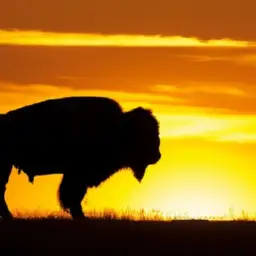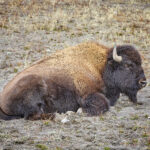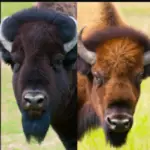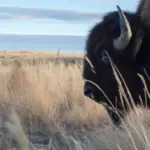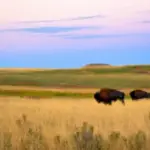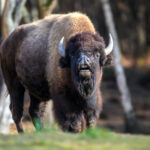Imagine a world where you could embark on an adventure to discover the extraordinary habitats of bison. With the fascinating product, “Bison Where Do They Live,” you can do just that! This innovative and informative tool takes you on a virtual journey to explore the different regions where these majestic creatures roam. Delve into the world of bison and expand your knowledge of their habitats, gaining a newfound appreciation for these incredible animals. Get ready to be mesmerized by the captivating landscapes and learn about the incredible adaptations that allow bison to thrive in their diverse environments.
Definition and Overview of Bison
Bison, also known as American buffalo, are large, herbivorous mammals that belong to the Bovidae family. They have a distinct hump on their shoulders, a massive head, and curved horns. Bison are known for their strength, resilience, and iconic presence in the wild.
Description of Bison
Bison are imposing creatures, with adult males, known as bulls, weighing up to 2,000 pounds and standing about 6 feet tall at the shoulder. They have a thick coat of fur that changes from dark brown in the summer to lighter brown in the winter, helping them adapt to different environments. Their horns, which can grow up to 2 feet long, are formidable weapons used for defense and dominance battles.
Difference between Bison and Buffalo
Contrary to popular belief, bison and buffalo are not the same. While they may appear similar, there are notable differences between the two. The term “buffalo” is often used colloquially to refer to bison in North America. True buffalo, such as the African buffalo and the water buffalo, belong to a different genus.
Bison have a distinctive hump on their shoulders, while buffalo have a more even profile. Additionally, buffalo possess larger and more curved horns compared to bison. Despite these differences, bison and buffalo share some similarities, including their herbivorous diet and their role as keystone species in their respective ecosystems.
Bison Species
There are two recognized species of bison: the American bison (Bison bison) and the European bison (Bison bonasus). The American bison is native to North America, while the European bison can be found in various countries across Europe. Although they belong to the same genus, the two species have distinct physical characteristics and habitats, which will be further explored in this article.
General Habitat of Bison
Overview of the Habitats
Bison have a wide range of habitats, adapting to various landscapes across North America and Europe. They are primarily found in grassland and prairie regions, as well as forested areas. Bison require large expanses of open spaces with access to water sources, making plains, meadows, and river valleys ideal habitats for their survival.
Adaptations for Their Habitats
To thrive in their habitats, bison have developed several adaptations. Their strong, muscular bodies allow them to roam vast distances in search of food and water. They have well-developed senses, especially their sense of smell, which helps them detect predators and locate resources. Bison also possess a specialized digestive system that enables them to efficiently process tough, fibrous grasses.
Their thick fur provides insulation during harsh winters, while their dark brown coloration helps to absorb sunlight, aiding in thermoregulation. Furthermore, bison have sturdy, sharp hooves that allow them to navigate through various terrains and dig through snow in search of vegetation during the winter months.
Habitat Selection by Species
The choice of habitat varies between the American and European bison due to their distinct evolutionary histories. American bison are well adapted to the vast grasslands and prairies of North America, whereas European bison inhabit diverse ecosystems, including forests, meadows, and marshlands. This divergence in habitat preferences is a result of differences in available resources and historical factors that shaped each species’ range.
Bison in North America
American Bison Habitat
The American bison, once highly abundant across North America, primarily occupies the Great Plains region. They are well-suited to the grasslands and prairies that dominate this area, as they provide ample grazing opportunities. American bison have also been reintroduced to selected national parks and protected areas, where their populations have been able to rebound.
Migration and Movements
Historically, American bison were migratory, moving in large herds across vast distances to find food and water. However, with the constriction of their habitats and the impact of human activities, their migration patterns have been substantially altered. Today, bison populations in North America are more sedentary, confining their movements to smaller home ranges or within protected areas.
Survival in Challenging Environments
American bison have demonstrated remarkable resilience in surviving challenging environments. They can endure harsh winters by accessing snow-packed vegetation and using their powerful bodies to dig through snowdrifts. Bison are also able to endure drought conditions, as they have the ability to extract moisture from vegetation and withstand prolonged periods without access to water.
Bison in Europe
European Bison Habitat
The European bison, often called Wisent, is found in fragmented populations across several countries in Europe, including Poland, Belarus, and Russia. These bison inhabit a range of ecosystems, such as dense forests, open grasslands, and wetlands. They have a more diverse habitat preference compared to their American counterparts, reflecting the diverse landscapes of Europe.
Compared to American Bison Habitat
European bison differ from American bison in their ability to adapt to forested environments. The European bison’s habitat diversity is likely due to its long history in Europe, dating back to the Ice Age. Their ability to thrive in forested areas showcases their adaptability to different ecological niches and highlights their importance in maintaining biodiversity within European ecosystems.
Conservation Efforts in Europe
Conservation efforts in Europe have played a crucial role in protecting and restoring the European bison population. Thanks to these efforts, the European bison has made a remarkable recovery from the brink of extinction. Several breeding programs and reintroduction projects have been implemented, focusing on establishing viable populations in protected areas and connecting fragmented habitats. These initiatives aim to preserve the unique genetic diversity of the European bison and ensure its long-term survival.
Impact of Human Activities on Bison Habitat
Changes in Bison Habitat due to Human Activities
Human activities have significantly impacted bison habitats, particularly in North America. Historical practices such as hunting, habitat destruction, and the expansion of agriculture led to a dramatic decline in American bison populations. These activities caused the fragmentation and loss of their once vast grassland habitats, disrupting their natural migratory patterns and reducing the availability of suitable grazing areas.
Bison Displacement
The displacement of bison populations has been a direct consequence of human settlement and development. As Native American tribes were forcibly relocated, their traditional hunting grounds were replaced by farms, towns, and cities. The loss of traditional bison range and the introduction of fences and barriers further restricted the movement of bison, isolating populations and reducing genetic diversity.
Reintroduction Efforts in Native Habitats
Efforts to reintroduce bison to their native habitats have been instrumental in restoring their populations and habitats. Through collaboration with indigenous communities, conservation organizations, and government agencies, projects have been undertaken to establish bison herds on tribal lands and protected areas. These initiatives not only help restore the ecological balance but also contribute to cultural revitalization and the preservation of traditional practices.
Bison in National Parks and Protected Areas
The Role of National Parks in Bison Conservation
National parks and protected areas play a crucial role in the conservation of bison populations. These designated spaces provide protected habitats that allow bison to live and thrive without human interference. National parks also facilitate research, monitoring, and management efforts to ensure the health and sustainability of bison populations. By conserving these iconic creatures, national parks contribute to the preservation of biodiversity and the education of visitors about the importance of wildlife conservation.
Examples of Bison in National Parks
Yellowstone National Park in the United States is renowned for its bison herds, which symbolize the park’s wild character. Here, bison roam freely across vast landscapes, displaying their natural behaviors and contributing to the overall ecosystem functioning. Other national parks, such as Banff National Park in Canada and Bialowieza National Park in Poland, have also successfully reintroduced bison and are working towards their long-term conservation.
Impact of Tourism
Tourism can have both positive and negative impacts on bison populations and their habitats. On one hand, responsible tourism can generate awareness, support conservation efforts, and provide economic benefits to local communities. The revenue generated from tourism can contribute to the preservation and management of national parks, ensuring the long-term protection of bison habitats.
However, unregulated or unsustainable tourism can disrupt bison behavior, cause habitat degradation, and introduce invasive species. It is vital for park management authorities and visitors alike to prioritize sustainable practices, including staying on designated trails, respecting wildlife boundaries, and minimizing disturbances to maintain the integrity of bison habitats.
Bison in Zoos and Captivity
Overview of Bison in Captivity
Bison conservation efforts extend beyond their natural habitats, as many bison are kept in zoos and captive breeding programs around the world. Zoos provide a controlled environment where bison can be protected, studied, and bred, helping to preserve genetic diversity and safeguard against extinction. Captive breeding programs often collaborate with wild populations, as the captive-bred individuals can be reintroduced to augment or establish new populations in suitable habitats.
Benefits and Drawbacks
The captive population of bison has both benefits and drawbacks. One significant benefit is that zoos and captive programs act as “arks” for endangered populations, serving as a safeguard against unforeseen catastrophes or diseases that may affect wild populations. Additionally, the controlled environment in captivity allows for scientific research and educational programs that aim to raise awareness about bison conservation.
However, the captive environment presents challenges such as limited space, restricted natural behaviors, and potential genetic issues due to small population sizes. It is crucial that zoo facilities prioritize the welfare of captive bison by providing ample space, enrichment, and social structures that mimic natural herds as closely as possible.
Contribution to Species Conservation
Bison in captivity not only serve as a vital genetic reservoir but also play an active role in conservation efforts. Through carefully planned reintroduction programs, captive-bred bison can be successfully released into suitable habitats, strengthening wild populations and increasing their genetic diversity. The collaboration between captive facilities and conservation organizations is essential in ensuring the long-term survival of the species and the preservation of their habitats.
Bison Behavior in Different Habitats
Social Structure of Bison Herds
Bison are highly social animals, forming tight-knit herds of varying sizes depending on the habitat and time of year. These herds are often led by dominant males, known as herd bulls, who are responsible for protecting the group and leading them to grazing areas. Females form the core of the herd, with strong social bonds and a hierarchical structure based on age and dominance.
Habitat Influence on Behavior
Habitat characteristics influence the behavior of bison. In open grasslands, herds tend to be more extensive and dispersed, allowing them to graze over larger areas. Forested habitats, on the other hand, may lead to the formation of smaller herds with reduced visibility and more restricted movements. The availability of water sources, the presence of predators, and the quality and abundance of vegetation all shape the behavior and distribution patterns of bison within their habitats.
Seasonal Changes in Behavior
Within their habitats, bison also display seasonal changes in behavior. During the mating season in late summer and early fall, known as the rut, dominant males engage in fierce battles for mating rights. This period often leads to increased aggression and vocalizations within the herds. In colder months, bison form tighter groups to conserve heat and search for food in areas where snow cover is minimal. These behavioral adaptations allow them to effectively navigate the challenges of changing seasons and ensure their survival.
Climate Change and Bison Habitats
Impacts of Climate Change on Bison Habitats
Climate change poses significant challenges for bison habitats. Rising temperatures, changes in precipitation patterns, and the increased frequency and intensity of extreme weather events can impact the availability and quality of food and water sources. Climate change may lead to shifts in the distribution of vegetation, altering the composition of grasslands and forests on which bison depend.
Additionally, climate change can disrupt seasonal patterns and impact the timing of migration, breeding, and calving, thereby affecting the survival and reproductive success of bison populations. The ability of bison to adapt and respond to these changes will be crucial in maintaining their habitats and ensuring their long-term viability.
Bison Adaptation to Climate Change
Bison have displayed remarkable resilience and adaptability throughout their evolutionary history, and they may have the capacity to cope with certain aspects of climate change. Their ability to graze on a wide variety of plants allows them to adjust their diet in response to changing vegetation patterns. Bison can also modify their movements and behavior to find suitable areas with adequate forage and water, demonstrating their adaptive strategies in the face of environmental challenges.
Conservation Strategies in Climate Change Context Conservation efforts in a climate change context focus on preserving and restoring the ecological integrity of bison habitats. This includes implementing habitat management practices that enhance the resiliency of ecosystems, such as controlling invasive species, promoting native plant diversity, and restoring degraded habitats. The establishment of corridors and connectivity between fragmented habitats can facilitate movement and gene flow, allowing bison populations to adapt and respond to changing climatic conditions.
Furthermore, continued research and monitoring are essential for understanding how climate change impacts bison and guiding effective conservation strategies. By addressing the underlying causes of climate change and adopting sustainable practices in all aspects of human life, the global community can play a critical role in mitigating the impacts of climate change on bison habitats and ensuring the long-term survival of this iconic species.
How Does the Habitat of Bison Affect Their Production of Tallow?
The habitat of bison greatly impacts their production of tallow. Grassland habitats provide the necessary vegetation for bison to graze on, which can enhance the quality and quantity of bison tallow. Bison tallow benefits and uses include being a source of essential fatty acids and a key ingredient in skincare products.
Future of Bison Habitats
Predictions for Future Bison Habitats
The future of bison habitats is complex and uncertain due to the dynamic nature of environmental, social, and economic factors. However, there are some predictions based on current knowledge and ongoing conservation efforts. As the understanding of the importance of bison ecosystems grows, there is a growing recognition of the need to expand protected areas and restore bison populations to their historical ranges.
Efforts to Preserve and Expand Bison Habitats Preserving and expanding bison habitats requires a multifaceted approach involving collaboration between conservation organizations, governments, indigenous communities, and the general public. This includes establishing and maintaining protected areas, restoring degraded habitats, implementing wildlife corridors, and promoting sustainable land-use practices. The engagement and support of local communities are crucial in ensuring the success of these efforts, as their livelihoods often intertwine with bison habitats.
Role of the Global Community in Habitat Conservation
The conservation of bison habitats extends beyond national boundaries and requires a global effort. Like many other endangered species, bison face challenges that transcend political boundaries. The global community plays a critical role in supporting and promoting habitat conservation through international collaborations, partnerships, and the implementation of sustainable policies aimed at preserving biodiversity and protecting crucial ecosystems.
By raising awareness, supporting research, and advocating for stronger conservation measures, individuals can contribute to the collective effort of protecting bison habitats and ensuring the continued existence of these magnificent animals for future generations to enjoy.
In conclusion, bison are majestic creatures that have adapted to a variety of habitats in North America and Europe. They have faced numerous challenges throughout history, including habitat loss, hunting, and climate change. However, through conservation efforts and a growing recognition of their ecological importance, bison populations have started to recover, ensuring their place in the wild. The future of bison habitats depends on the collective actions of governments, conservation organizations, and the global community to protect and restore their ecosystems, ensuring a harmonious coexistence between humans and these magnificent animals.

